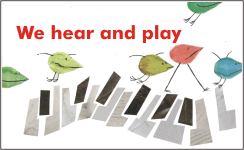
Click to return to the home page
I feel highly privileged to present you with this groundbreaking work from Ruth and Naoyuki Taneda. I first encountered this book, in its original German, while conducting research on absolute pitch and how to teach it to adults. I began translating the book out of curiosity, and I finished due to utter fascination. We Hear and Play is what every parent has been hoping for.
The goal of We Hear and Play is total musical literacy. We Hear and Play teaches absolute pitch (also known as “perfect pitch”) which is the foundation for a natural, instinctive relationship to musical language. Think about how clearly you hear your own language: when you hear words, you can write down every letter; when you speak, you compose sentences instantly and effortlessly. A We Hear and Play student enjoys this same deep understanding of music. The student will gain the power to express musical ideas with freedom and joy. We Hear and Play allows a child to “think in music” as a language all its own.
This book tells you not to ignore the ear-training exercises in favor of piano playing. This is because piano playing is ultimately a direct extension of the listening exercises. The piano becomes a kind of “typewriter” with which a child speaks their new musical language. They must hear the sounds mentally to play the instrument fluently and effortlessly. The We Hear and Play ear training techniques are the foundation of its piano instruction method.
The time has come for the We Hear and Play method to be revealed to the world. I find it easy to believe that any parent would gladly teach their child to know pitch sounds as surely as they know colors. Who knows how the world may be changed by this strange new language? The coming generation will discover a meaning and delight in sound which has, until now, been inaccessible to humankind.
Foreword by Naoyuki and Ruth Taneda
Frequently Asked Questions about Absolute Pitch
Introducing Traditional Notation, part 1